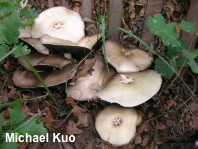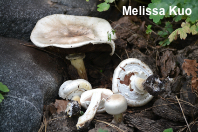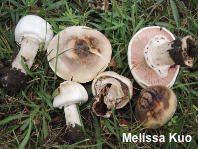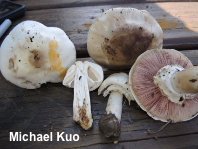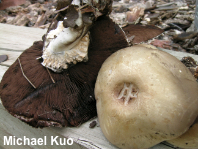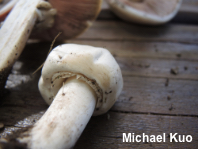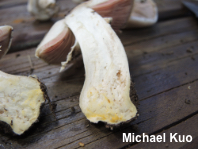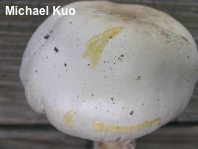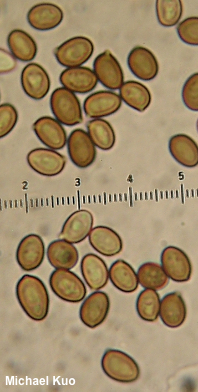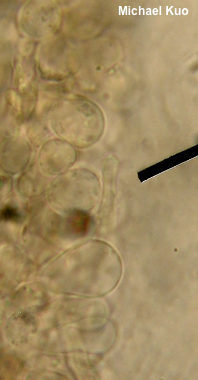| Major Groups > Gilled Mushrooms > Dark-Spored > Agaricus > Agaricus malangelus |

|
Agaricus malangelus [ Basidiomycota > Agaricales > Agaricaceae > Agaricus . . . ] by Michael Kuo This newly named species of Agaricus was originally described from northern New Mexico and, assuming I have identified it correctly, I am reporting it from southwestern and central Colorado. Agaricus malangelus features a whitish to pale brownish cap with a darker, grayish brown center, along with yellow flesh in the base of the stem and spores that are somewhat wider than the spores of similar species. It appears at middle elevations, in pinyon-juniper ecosystems and under lower-elevation pines. My collections, from Durango and Buena Vista, Colorado, were made in urban locations, in subdivisions built in Colorado pinyon/Rocky Mountain juniper/Ponderosa pine ecosystems. Agaricus malangelus has a distinctive appearance. When young its cap is pale and blocky, and the developing ring protrudes from the bottom of the cap; the stem at this stage appears proportionally long in relation to the cap. At maturity, however, the stem does not seem so tall, and the cap has expanded to a broadly convex shape, often with a shallow central depression where the surface is darker. Description: Ecology: Saprobic; growing gregariously near Colorado pinyon, Rocky Mountain juniper, Ponderosa pine, Gambel oak, and other middle elevation trees; July and August; southern Rocky Mountains. The illustrated and described collections are from Colorado. Cap: 5–13 cm; blocky-convex at first, becoming broadly convex or nearly flat, often with a shallow central depression over the stem; dry; very finely fibrillose or nearly bald; whitish to very pale brownish at first, becoming whitish with a darker, grayish brown center at maturity; not bruising when rubbed, or bruising faintly yellow. Gills: Free from the stem; close or crowded; short-gills frequent; white in the button stage, then pink, and eventually becoming dark brown; when in the button stage covered with a thick, rubbery, whitish partial veil that sometimes features brownish discolorations. Stem: 5–12 cm long; 1.5–3 cm thick; more or less equal above a slightly swollen base; bald; with a whitish, skirtlike ring; whitish, discoloring brownish; sometimes bruising yellow; basal mycelium white. Flesh: White overall, but yellow in the stem base when sliced. Odor and Taste: Odor strong and unpleasant, or not distinctive. Chemical Reactions: KOH yellow on cap surface. Spore Print: Dark brown. Microscopic Features: Spores: 6–8 x 4.5–5.5 µm; ellipsoid; smooth; thick-walled; brown in KOH; brown in Melzer's. Basidia 4-sterigmate. Cheilocystidia not always found but when present in chains of subglobose elements 3–6 µm wide, with a clavate to pyriform terminal cell up to 10 µm wide; thin-walled; hyaline in KOH. Pleurocystidia not found. Pileipellis a cutis; elements 2.5–7.5 µm wide, smooth, hyaline to brownish in KOH. REFERENCES: R. Kerrigan, 2016. (Kerrigan, 2016.) Herb. Kuo 07250601, 07241302, 08111503. This site contains no information about the edibility or toxicity of mushrooms. |
© MushroomExpert.Com |
|
Cite this page as: Kuo, M. (2018, April). Agaricus malangelus. Retrieved from the MushroomExpert.Com Web site: http://www.mushroomexpert.com/agaricus_malangelus.html |
